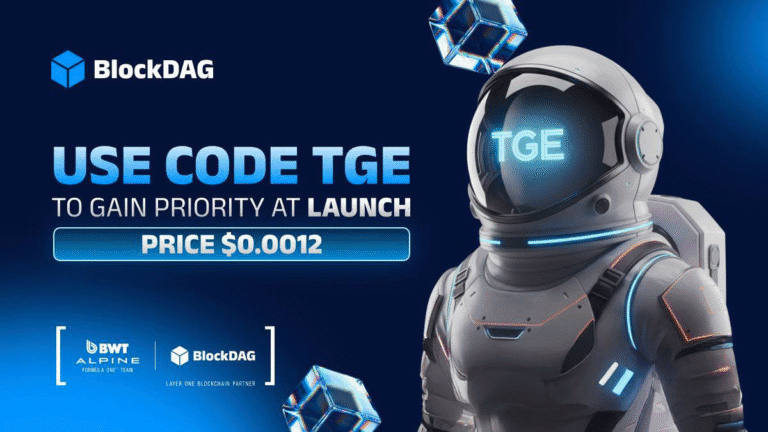Sui’s Token Unlock Shakes Confidence, & Pi’s AI Push Gains Traction, as BlockDAG’s $435M Presale Emerges as the Institutional Pick
| Disclosure: This post is a paid advertorial contributed by a third party. It is separate from our editorial opinions and is not intended as financial advice. |
The excitement around established ecosystems like Sui (SUI) with its 10x potential or Pi Network (PI) driven by strong community growth shows a market craving disruptive returns. Yet, many overlook the calculated, institutional-grade challenger.
As next-gen crypto projects of 2025 deliver real adoption and performance, the question arises: will first-mover advantage dominate, or will flawless execution win?
BlockDAG (BDAG), known as “The Giant Killer,” challenges this idea. Led by CEO Antony Turner, formerly of Spirit Blockchain and SwissOne Capital, the project blends Bitcoin’s Proof-of-Work security, Solana’s 15,000 TPS speed, and Ethereum’s EVM compatibility to challenge Layer-1 monopolies. Its record-breaking $435 million presale shows that institutional investors believe Turner’s strategy could make the ambitious $1 target a realistic milestone.
BlockDAG’s $435M Presale Signals a Shift Toward Real Execution
BlockDAG is drawing serious attention for how it’s structuring its growth, not through hype but through planning. CEO Antony Turner, with experience from Spirit Blockchain and SwissOne Capital, has introduced a system that blends Bitcoin’s Proof-of-Work reliability with Solana-level speed and Ethereum’s EVM flexibility. This mix is not experimental; it is built to solve long-standing scalability issues that challenge even the strongest Layer-1 networks. Many new crypto coins 2025 promise innovation, but BlockDAG’s strategy is to prove it through transparent execution and technical discipline.
The project’s presale has been one of the largest in recent memory, raising $435 million with a firm closing date of February 10, 2026. Turner’s decision to set this hard deadline rather than running an open-ended funding round shows confidence and accountability. The presale is almost sold out with 4.4 billion coins left, creating a built-in scarcity model that strengthens long-term value. The structure is simple: 40% of tokens are released upfront, while the remaining 60% follow a vesting schedule, encouraging holders to stay committed to the ecosystem’s growth.
As new crypto coins 2025 compete for credibility, BlockDAG stands out for treating its roadmap like a contract, not a marketing pitch. Its approach reflects a shift from speculative trading to performance-driven building, where results, not slogans, determine who leads the next phase of blockchain adoption.
The Two Sides of Sui’s (SUI) 10x Potential
Sui remains one of the most capable Layer-1 blockchains targeting large-scale adoption, though it faces pressure between solid fundamentals and short-term selling. The network is prioritizing gaming as its main growth driver. On October 30, 2025, the Sui Foundation appointed Electronic Arts co-founder Bing Gordon as an advisor, reinforcing its Web3 gaming ambitions after partnering with CCP Games for EVE Frontier. This strategy, combining top gaming talent and major IPs with Sui’s Move-based architecture and strong DeFi ecosystem (Momentum DEX exceeding $26 billion in volume), continues to support the SUI 10x potential narrative.
However, Sui’s vision is being tested by liquidity challenges. A $147 million token unlock in November caused a sharp price drop on October 30. If SUI can hold key support levels while institutional interest grows through an updated ETF filing with staking, its long-term outlook remains strong heading into 2026.
PI Turns Its Node Grid Into an AI-Powered Ecosystem
The surge in Pi Network (PI) coin sentiment is driven by its bold move toward real-world use beyond payments. On October 29, 2025, Pi Network Ventures announced its first investment in OpenMind, an AI robotics company developing a decentralized operating system for intelligent machines. This partnership transforms Pi’s 350,000+ global nodes into a “peer-powered AI grid.” A successful proof of concept confirmed that Pi Node operators can perform AI computational tasks for third parties, creating a new utility cycle where AI companies compensate Node operators in PI for computing services.
This development marks a major evolution for the mobile-first project, shifting from community enthusiasm to tangible AI infrastructure. Speculation around Pi’s alignment with the ISO 20022 global payment standard, set for major bank adoption in November, has further boosted optimism. Alongside its AI-powered KYC system, which has verified over 3.36 million users, Pi Network is aligning its ecosystem with traditional finance, provided it executes its mainnet and utility plans successfully.
Summing Up
Both Sui (SUI) 10x potential and Pi Network (PI) coin growth reveal how utility-focused innovation is defining the next stage of blockchain development. Sui is doubling down on gaming partnerships and technical strength, while Pi is transforming its community power into usable AI infrastructure.
Both prove that sustainable success depends on real-world application rather than hype. Their respective challenges, token unlock pressure for Sui and execution demands for Pi, will determine their ability to maintain investor confidence in the coming months.
Among new crypto coins 2025, BlockDAG distinguishes itself with structure and accountability. Its fixed presale cap, February 2026 deadline, and transparent vesting plan show a model built on measurable results, suggesting that true progress will outlast short-term speculation.
Presale: https://purchase.blockdag.network
Website: https://blockdag.network
Telegram: https://t.me/blockDAGnetworkOfficial
Discord: https://discord.gg/Q7BxghMVyu
| Disclaimer: The text above is an advertorial article that is not part of bitcoininfonews.com editorial content. |



